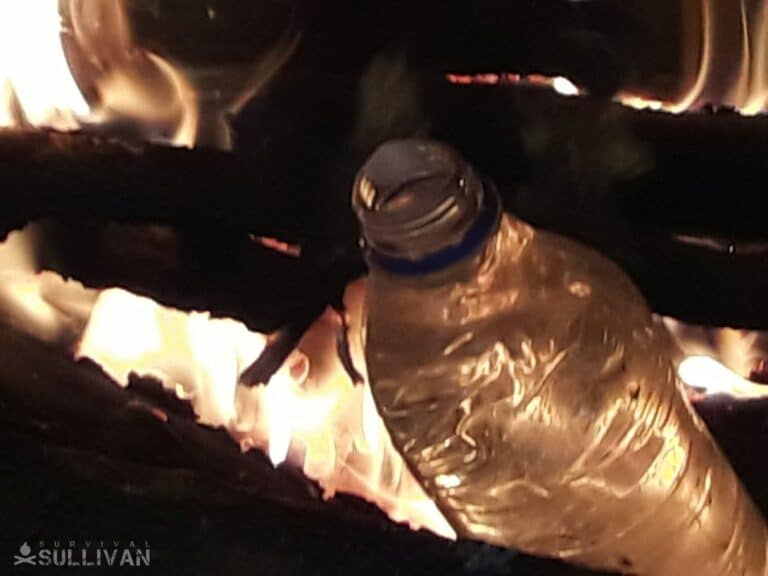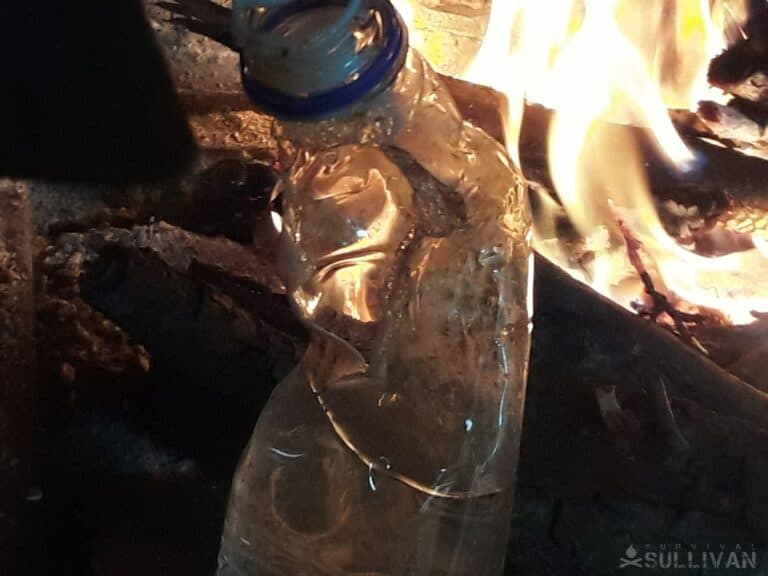When you’re out in the wilderness, it’s possible that you may have to take water from a lake or river to refill your bottle(s) – if you’ve got access to them. With that said, you can’t always drink it directly; there could be all kinds of funky things in it which will make you sick.
One way to get around this problem is to boil the water to kill off the bacteria, viruses and parasites lurking within. Usually, you’d use a pot but what if you don’t have a pot with you?

What about plastic water bottles? We’re always told that you shouldn’t burn plastic because it can give off toxic fumes or leach chemicals into the water, but can you actually boil water in a plastic bottle?
Yes, you can boil water in a plastic bottle (and it’s easy to do), but it isn’t recommended because there’s a risk of the plastic releasing toxic fumes into both the air and the water. Plus, the water itself tastes awful.
Burning Plastic is Generally a Bad Idea
The process of boiling water in a plastic bottle typically involves the use of a fire and usually burning plastic is something we’re advised NOT to do.
The reason being that it can give off toxic fumes which can make you decidedly ill. Plastic contains a chemical called Bisphenol A (BPA) and other chemicals called phthalates.
BPA is a clear solid which is used in lining food and beverage cans as well as in certain plastics. It’s also used to make thermal paper (like what you’d find in sales receipts) and certain epoxy and vinyl resins.
There is some debate about whether or not plastic toxins cause serious harm but it’s ability to mimic estrogen and the presence of certain steroids cause the chemical to bind to certain cells in the body and disrupt endocrine system.
BPA also affects the human reproductive system and there are some previous studies that link the chemical to some really nasty diseases.
Phthalates are chemicals that are added to plastics to increase durability, flexibility, transparency, and their general longevity. Unfortunately, there are also significant health-related issues with these chemicals.
Like BPA, Phthalates affect the endocrine and reproductive systems by inhibiting the production of hormones, decreasing arousal and satisfaction (in women) and decreased fertility in men – although, there hasn’t been any concrete proof of this.
How to Do It
The process of boiling water in a plastic bottle is very simple. You start a fire and place the bottle of water in the fire; moving the bottle around every so often to get an even heat.
Once the water reaches 212 degrees Fahrenheit, it is boiling. You can leave the lid on – loosely fastened – or remove it; the water will boil either way but it’ll boil faster if the lid is on.
A word of caution if you decide to do this, make sure that you do it outside; doing it indoors can add unnecessary safety risks.

I Decided to Try It
Recently I was doing an article about methods to boil water without a pot and one such method involved taking a soda bottle, filling it with water and sticking it in a fire to boil.
As I said before, this is generally considered a bad idea and we’re always told NOT to do it. With that in mind, I was a bit skeptical, so I decided to try it…you know…for science.
It took some doing but I got my fire going and braced my bottle at a slight angle between some of the logs. Initially, I had the lid on the bottle, but I eventually removed it.
Initially placed in front of the fire with a few logs keeping it away from the flames, I moved the logs around a bit and placed the bottle closer to the heat.

I watched for deformation and discoloration, but my chief concern was the possibility of toxic fumes. After about a minute, the heat started to cause deformation in the bottle and steam started coming out of the top.
It took about five minutes or so before I removed the bottle from the heat – unfortunately I dropped the bottle which put boiling hot water all over the place (which wasn’t pleasant).

Can You Pour Boiling Water into a Plastic Bottle?
You can, and though it won’t release as many chemicals from the plastic compared to the raging heat of open flames, it will still cause the same BPA and phthalates to leech into the water somewhat.
Not for nothing, this maneuver is also highly dangerous! Disposable water bottles all have tiny necks, and it will be easy to spill the boiling water during the attempt, potentially causing serious injury.
You might attempt to do so with a funnel and plenty of caution, but I would advise you wait until the water cools, first!
Should You Even Try to Boil Water in a Plastic Bottle During an Emergency?
That’s a tough question to answer definitively. It is a dilemma, that is for sure: On the one hand, the chemicals released from the plastic are something to take seriously, even in the short term with regular consumption.
But dehydration can be a certain killer on its own, particularly if you are puking your guts out or suffering explosive diarrhea thanks to some waterborne germ.
The only thing I can tell you for sure is that you’ll need to perform you own evaluation of risks. What is at stake? What are you facing? What other options do you have? How bad is the water likely to be? Then choose and follow through.
In any case, it is a great reason why you should carry chlorination tablets or other heatless purification options in your survival kit.
Would a Nalgene Bottle Work Better?
Compared to disposable bottled water bottles, Nalgene and many other manufacturers’ hard polycarbonate plastic water bottles are much tougher and often BPA-free. That’s the good news. The bad news is that they’re not necessarily safe when it comes to boiling water, either.
The fact is that most plastic deteriorate quickly under intense heat to say nothing of open flames. It is for this reason that most manufacturers’ instructions will tell you not to keep their products away from high temperatures that can warp or melt the plastic.
This certainly goes for boiling water, though this bottles might fare better when boiling water is poured into them.
Ultimately, no, I would not recommend using a Nalgene bottle as a safe alternative, though it would probably work in a pinch.
Can You Microwave Water in a Plastic Bottle to Boil It?
The jury is still out on this one. Some studies say yes, it’s perfectly safe. Others suggest that it might be better to avoid microwaving water in plastic.
I tend to err on the side of caution and would not recommend doing so since we know that boiling water alone is still plenty hot enough to leach some chemicals from the plastic.
But in any case, it is again likely a safer bet than trying to boil the water in a plastic bottle over an open flame. Of course, if you have access to a working microwave you probably don’t need to worry about clean drinking water, either!
Metal Water Bottles Will Allow You to Boil Water Safely
If you have a stainless steel bottle you can definitely use that to boil water safely over a fire. Just make sure the cap is removed to avoid a dangerous buildup of pressure.
If your steel bottle has a plastic liner, you might be facing the same problems that you would be with a plastic bottle, even if the bottle itself is able to withstand the heat of open flame and boiling water.
Try Solar Disinfection if all You Have are Plastic Bottles
If you are in serious need of water disinfection and all you have is a plastic bottle, don’t give up hope: you aren’t necessarily facing a choice between drinking nasty, germ contaminated water or nasty, chemical contaminated water.
One option that doesn’t require any flame or intense heat at all is solar disinfection, also known as SODIS. The basic idea is to fill your (transparent) plastic bottle with water, screw on the cap and then place it in direct sunlight for at least 12 hours.

Yes, it will take a while, but this process is actually quite effective at killing off waterborne pathogens using nothing but sunlight alone. We have a great article all about it right here.
The Final Verdict
So, the final verdict? Yes, you can boil water in a plastic bottle. Can you drink it? Well… sort of; it tastes awful and it’s probably not very good for you but, if you’re in a desperate situation with no other alternative, then it’s better than nothing.
In closing, I hope you enjoyed the article and found it informative. As always, thanks for reading and I’ll see you in the next one very soon. Take care!











































